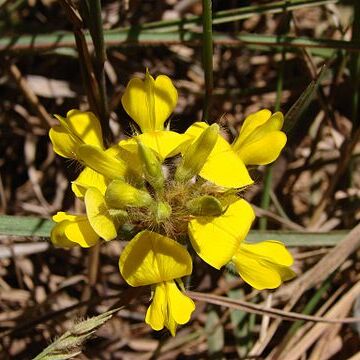Perennial herbs or subshrubs; stems angular to terete, striate, pubescent. Leaves trifoliolate or rarely unifoliate; leaflets gland-dotted below; stipules lan-ceolate or oblong, usually persistent. Inflorescence axillary or terminal, race-mose, the flowers sometimes congested at the tips; bracts lanceolate, striate strig-ulose, caducous. Flowers with the calyx campanulate, the teeth 5, gland-dotted; corolla papilionaceous, the standard usually yellow with reddish purple to maroon striations, obovate with auriculate base, the wings narrowly oblong, lobed above the claw, the keel falcate; stamens 10, diadelphous, the vexillary stamen free, the anthers equal; ovary sessile or subsessile, villous, the style curved, slender, the stigma capitate. Fruit oblong, bivalved; seeds 2, ovoid, black, brown or mottled, the striophiole white, the hilum linear or oblong.
Herbs or subshrubs, erect or almost erect, usually with root tubers. Leaves 1-foliolate; stipules linear or linear-lanceolate; leaflets usually with sessile glands abaxially. Inflorescence axillary, 1-or 2-flowered to racemose. Calyx campanulate, 5-lobed. Corolla usually longer than calyx; standard obovate, abaxially silky hairy, base clawed, with auricles; wings and keels usually much shorter than standard. Stamens diadelphous; vexillary stamen free; anthers uniform. Ovary sessile; ovules 2; style filiform, glabrous; stigma small, capitate. Legume rhombic-elliptic or oblong, dehiscent, inflated, not septate. Seeds 1 or 2, oblique; hilum linear, funicle at one end.
Corolla small to medium-sized, usually basically yellow; standard auriculate or not, with or without appendages inside, glabrous to velvety and glandular outside.
Leaves pinnately or rarely digitately 3(6)-foliolate or 1-foliolate; leaflets often with small glands beneath; stipules present but stipels often absent.
Calyx 5-lobed; lobes equal or unequal, the upper pair free or sometimes partly fused particularly in subgen. Becquetia, often glandular.
Ovary 2-ovuled, covered with long or short hairs; style bent at or below the middle, glabrous above; stigma very small.
Pods oblong or ovate, compressed, velutinous (in subgen. Becquetia), covered with spaced long hairs or glabrescent.
Seeds 2, ovoid or oblong, with a linear hilum to which the funicle is attached at one end; rim aril ± developed.
Inflorescences axillary or terminal, racemose or rarely paniculate, short and condensed or elongated.
Herbs or subshrubs, erect or prostrate, rarely twining, occasionally pyrophytes.
Vexillary stamen free; anthers uniform.

